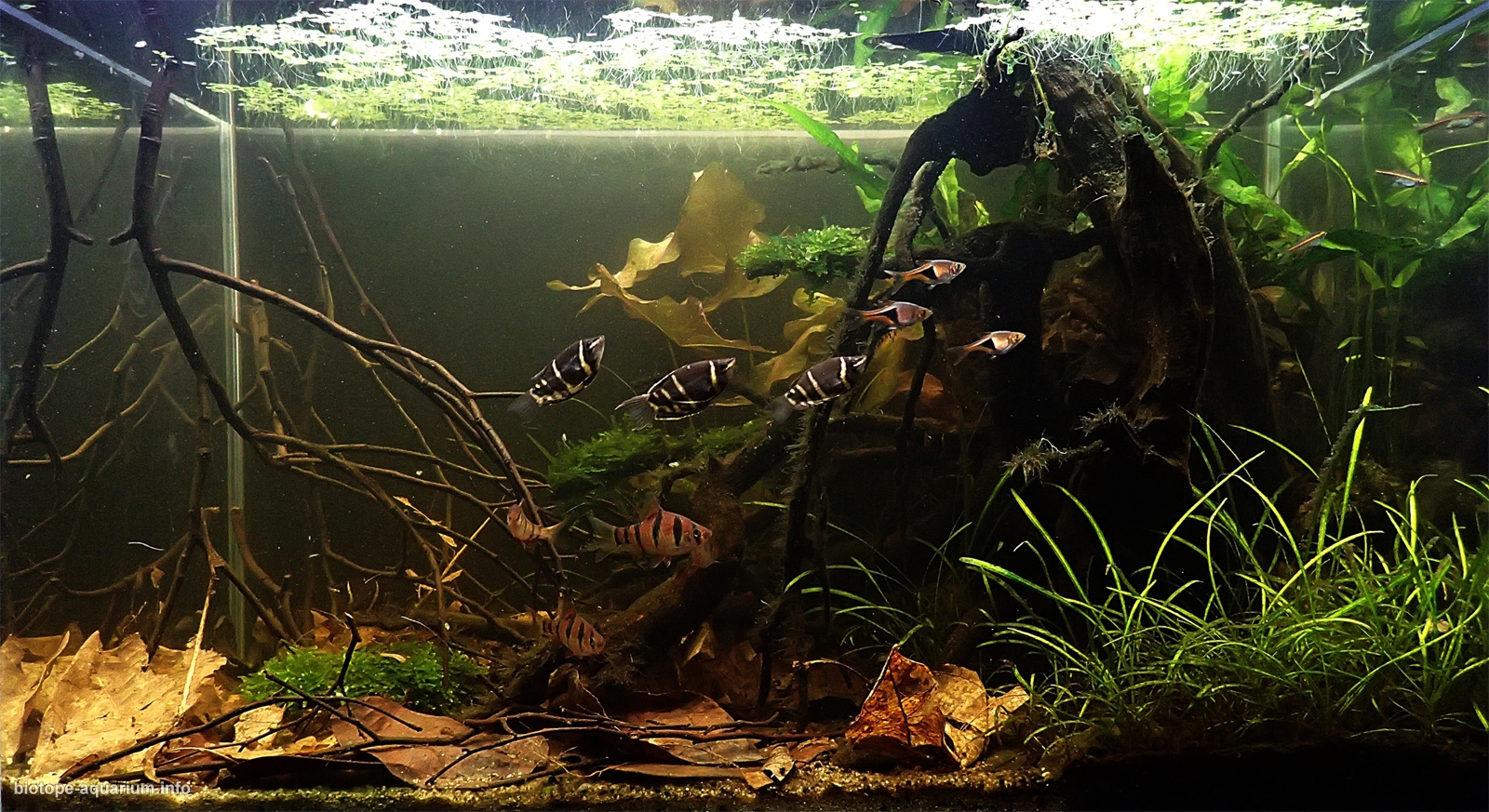Peat swamp forest in the central west of Peninsular Malaysia
11th place in Biotope Aquarium Design Contest 2017
![]() Malaysia. Khairuldin Mohd Isha
Malaysia. Khairuldin Mohd Isha

Volume: 60 L
Dimensions: 60x30x35 cm
List of fishes: Chocolate Gourami (Sphaerichthys osphromenoides), ‘Pentazona’ Barb (Desmopuntius hexazona), Harlequin (Trigonostigma heteromorpha), Glowlight Rasbora (Trigonopoma pauciperforatum), Licorice Gourami (Parosphromenus harveyi).
List of plants: Nymphaea rubra, Blyxa japonica, Lemna minor, Vesicularia montagnei, Riccia fluitans, Nepenthes mirabilis, Piptospatha ridleyi, algae (unknown species), dead leaves (Macaranga sp.).
Description of decorations: The floor was similar type of soil with half decomposed bog woods, new dead branches and Macaranga leaves. The colour of the water are very similar to those found in the nature biotope due to tannin provided by the dead leaves. Fishes are taken from the real habitats and few species had successfully been bred in thebiotope aquarium.
Description of equipment: EHEIM classic 150, Hailea HS-28A aquarium chiller (power: 1/10HP, rate of flow: 250-1200 L/h), Heto Super-Slim LED lamp (SS-24H / 60cm, 16 W, 1232 lm).
Water parameters: Temperature is 26°C, pH is 5.0, kH 3 and GH 4.
Description of the area surrounding the biotope: This aquarium was set up based on the peat swamp forest in the central west of Peninsular Malaysia. Malaysia’s peat swamp forests not only comprise unique ecosystems that are home to many endemic species but also provide sanctuary for viable populations. In this natural habitats, peat forms when plant material is inhibited from decaying fully by the acidic conditions and an absence of microbial activity. In unaltered habitats, the dense canopy of branches above provide very little light penetrates the surface of such environments, and riparian vegetation also tends to grow thickly. The water is typically stained darkly with humic acids and other chemicals released by decaying organic materials.
Description of the underwater landscape of the biotope: The black water swamp are waterlogged forests growing on a layer of dead leaves and plant material up to 20 meter thick. The swamps are maintained either by direct rainfall or by groundwater, which common in tropical regions with high rainfall like Malaysia. This produce slow-moving, well-shaded and shallow water (about 3 meter deep) habitats. The floor contain lots of bog woods, half decomposed
Description of the parameters of the habitat: Habitats is highly acidic tea-coloured water of between pH 3.5 to 6. Well shaded shallow waters, which temperature range between 22°C to 28°C. Water hardness below 50 ppm and conductivity about 145 mV.
List of fishes: Chocolate Gourami (Sphaerichthys osphromenoides), ‘Pentazona’ Barb (Desmopuntius hexazona), Harlequin (Trigonostigma heteromorpha), Glowlight Rasbora (Trigonopoma pauciperforatum), Licorice Gourami (Parosphromenus harveyi), Giant Pikehead (Luciocephalus pulcher), Leaffish (Nandus nebulosus), Dwarf Rasbora (Boraras maculatus), Betta Livida, Brilliant Rasbora (Rasbora einthovenii), Pearl Gourami (Trichopodus leerii), Bangka Snakehead (Channa bankanensis), Croaking Gourami (Trichopsis vittata).
List of plants: Cryptocoryne minima, Blyxa (auberti, japonica), Barclaya motleyi, Eleocharis sp., Utricularia gibba, Limnophila sessiliflora, Nepenthes mirabilis, Pandanus amaryllifolius and Lemna minor. Land vegetation near the swamp like Macarange sp. trees.
Threats to the ecology: The aquarium was set up to attract international attention to the problem of rapid reduction of peat swamp forest, particularly in Peninsular Malaysia. Of the remaining estimated 300,000 hectares, now left in the Peninsula, about 67 percent has been protected within Permanent Forest Reserves with theremainder in stateland forests. Almost all of the peat swamp forests within permanent forest reserves are designated production forests and are therefore available for sustainable logging, while those within the stateland forests are generally available for conversion into other land uses as well. One of the fish species use in the biotope aquarium is Parosphromenus harveyi. It is a species of Licorice Gourami endemic to the central west of PeninsularMalaysia. It has been listed as “Endangered” on the IUCN Red List since 1996, as its natural range is restricted to a very small and diminishing area of swampy water bodies in tropical forests. Its habitat is being diminished by the clearing of the forests to make way for oil palm cultivation. Conserving the forests is crucial not only to ensure sustainable and protection of endangered species, but also to maintain environmental stability.
Sources of information:
- Books: “Malaysia’s Conservation and Sustainable Use Peat Swamp Forests” published by the United Nations Development Programme (UNDP), Malaysia. “Cryptocoryne of Peninsular Malaysia” published by Penerbit Universiti Sains Malaysia.
- Articles: https://parosphromenus-project.org/en/p-harveyi , http://www.iucnredlist.org/details/16264/0 , https://news.mongabay.com/2014/07/what-is-peat-swamp-and-why-should-i-care/
Comments of the members of the jury of Biotope Aquarium Design Contest 2017

An exquisite little biotope, it manages to express the essence of a Malaysian peat swamp in miniature. Amidst a tangle of thin twigs, leaf litter, and algae-furred roots the plants seem to have sprouted naturally: the grasses spreading out by runners, mosses creeping over the exposed roots, and floating plants dappling the surface. The slightly turbid water lends the scene a soft ambiance, although I would have preferred a darker tannin stain. The behaviour of the fish is testament to how well the habitat has been portrayed, as they all display natural foraging and schooling behaviour in their respective roles: rasboras in the open zones, barbs flitting about the twigs and roots, and gouramis gliding about the shady spots, none interfering with any other.
